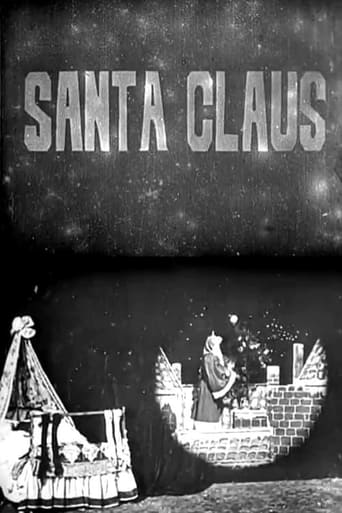He_who_lurks
You can't call this early Smith films' special effects outstanding for the time period, considering that exact same year Georges Melies made a film called "The Four Troublesome Heads" which has even more creative camera tricks. In terms of plot, however, this is pretty sophisticated considering most films at the time were plot-less and merely documented everyday life. In fact, considering its Christmas-y theme, you could call this the first holiday movie. I can imagine children being delighted back in 1898, and it's still a charming little gem even now.Some children want to stay up on Christmas Eve but a maid tucks them into bed. By the clever use of a matte shot, we see Santa go down the chimney. He then enters the room and fills the children's stockings, disappears, and the children wake up. That's all there is in this movie but you have to admit for 1898 it's really quite good compared to other movies of the era.
leplatypus
In 1898, the cinema is still a baby and it seems it's happy to play with its first gifts: the special effects! Back then, it was a true art that asked for inspiration, craft and intelligence! A bit like a Lynch's movie, here we got vision, mysterious drape and a fantasy character! But don't be afraid, as written in the title (again an innovation), it's only our dear good and friendly Santa! Thus, this time, it's an English movie as it was then mostly AngloSaxon culture! It's great to see how the home were furnished: the chimney was used to heat but only in upper classes buildings! Finally, the camera is still motionless and like the future security one, shots what happens in front of....
Michael_Elliott
Santa Claus (1898) *** (out of 4) This early British film is one of the first to show Santa Claus. The film is pretty simple as a couple kids want to stay up to see Santa but their mom makes them go to bed. We then see how Santa gets into their room without waking them up. This film runs 75-seconds so naturally one shouldn't expect a full story but it's interesting to note that they were at least trying to tell something and this is a full five years before THE GREAT TRAIN ROBBERY. What's interesting when viewing this film today is the look of Santa as they have him a lot thinner than we are use to see and he's also wearing more of a robe than an actual suit. The special effects used in the film are certainly primitive if you compare them to the stuff of today but for 1898 they're actually pretty good. I thought the effect of the mother turning the light off was something incredibly simple but the visual of it was terrific.
boblipton
Although D.W. Griffith is usually honored as the inventor of modern film grammar, most of the groundwork was laid down a decade earlier by George Smith of England. This is one of his early films.But even this particular Athena did not spring fully born from the mind of Zeus, and we can see that Smith is using a lot of magic lantern grammar -- the children dream of Santa and he appears in a small circular image in the upper right corner, straight out of the preceding technology's grammar. This particular technique would not vanish for another decade and a half -- and arguably is still in occasional use in such peculiarities as SHERLOCK JUNIOR and its successor THE PURPLE ROSE OF CAIRO as well as Jeunet's UN LONG DIMANCHE DE FIANCAILLES. Another point of interest is the title of this movie. Although Clement Clarke Moore's poem, 'A Visit from Saint Nick' was well known and popular, it's a Dutch and New York and hence American phenomenon. What was an Englishman, with their Father Christmas, doing playing with the idea? It seems to me that Smith may have been a far more important figure in popular culture than even I thought.
